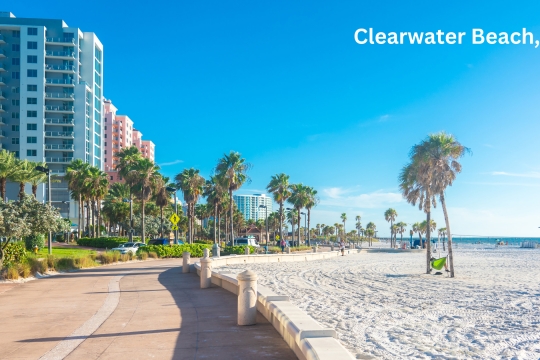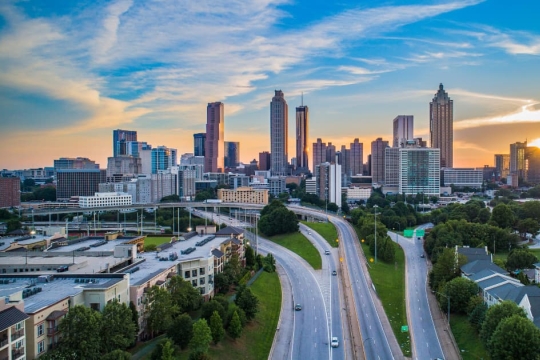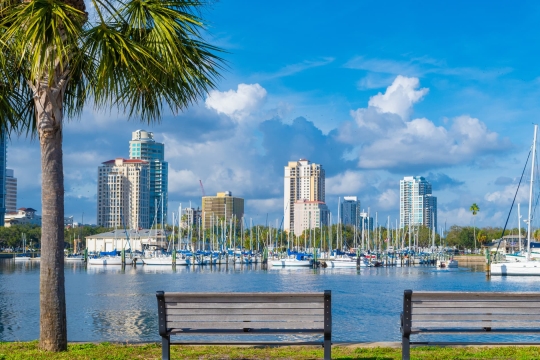Whether you’re planning your first trip to Norway or returning to see more, this guide covers the best things to do in Norway across every season. From cruising through the dramatic fjords to chasing the northern lights in the far north, there’s no shortage of must-do activities. Whether your interests include hiking to panoramic viewpoints, exploring Viking history, or experiencing the midnight sun above the Arctic Circle, consider this your ultimate guide to all the best places to visit in Norway.

- 6 Fun Facts About Norway
- 1. Cruise Through the Norwegian Fjords
- 2. Ride the Flåm Railway
- 3. Experience the Northern Lights in Tromsø
- 4. Visit the Lofoten Islands
- 5. Hike to Pulpit Rock (Preikestolen)
- 6. Explore Oslo
- 7. Discover Bergen – The Gateway to the Fjords
- 8. Step Back in Time at Viking Valley (Gudvangen)
- 9. See the Midnight Sun in Northern Norway
- 10. Drive the Atlantic Ocean Road
- 11. Visit the UNESCO-Rated Urnes Stave Church
- 12. Go Hiking in Jotunheimen National Park
- 13. Discover Trondheim – Norway’s Historic Heart
- 14. Chase Waterfalls Like Vøringsfossen
- FAQs
6 Fun Facts About Norway
- The midnight sun lasts for months: In parts of northern Norway, the sun doesn’t set at all from late May to late July, creating weeks of continuous daylight.
- Norway is home to eight UNESCO World Heritage Sites: These include the fjords of Geirangerfjord and Nærøyfjord, the Bryggen wharf in Bergen, and the wooden Urnes Stave Church.
- The Oslo Opera House has a walkable roof: Visitors can stroll across its sloping marble roof for panoramic views of the harbor and city center.
- The Lofoten Islands defy the Arctic climate: Despite lying above the Arctic Circle, the Gulf Stream keeps winters much milder than you’d expect.
- Norwegians love brunost, or brown cheese: This caramel-flavored cheese is a staple in Norwegian homes and is often served on waffles or bread.
- The Atlantic Ocean Road is a bucket-list drive: This 5-mile stretch of road skips across islands and bridges, and has been named one of the most beautiful drives in the world.
1. Cruise Through the Norwegian Fjords

Sailing through Norway’s fjords is one of the most memorable ways to experience the country. These deep, narrow inlets were carved by glaciers, and today their steep cliffs, green valleys, and cascading waterfalls create a dramatic setting best appreciated from the water. Popular fjords include Geirangerfjord and Nærøyfjord, both of which are listed as UNESCO World Heritage Sites.
Cruises typically run from May to September, when the days are long and conditions are mild. Even in summer, temperatures typically range from 13°C to 18°C, and rain is common; therefore, packing layers and waterproof clothing is recommended. The most visited ports are Bergen, Flåm, Geiranger, and Olden, each offering a range of shore excursions from historic villages to mountain viewpoints.
Travelers can choose between large cruise ships, smaller expedition-style voyages, or traditional Hurtigruten ferries that double as local transport. Some companies, like Havila Voyages, now use hybrid ships that lower emissions and serve locally sourced meals on board. Booking early for popular summer departures is advised, especially if you want a cabin with a balcony for uninterrupted views.
2. Ride the Flåm Railway
If you're looking for an authentic Norwegian journey, don’t skip the Flåm Railway. This train drops nearly 900 meters over 20 kilometers, winding through steep valleys and past 20 tunnels carved through rock. One of those tunnels takes a full 180° turn inside the mountain—engineering meets adventure in one ride.
The train glides between the fjord village of Flåm and the mountain station of Myrdal in under an hour. On return trips, the full round takes just over two hours, including the short wait in Myrdal before heading back.
For many, the highlight is Kjosfossen, a thunderous 225-meter waterfall where the train stops, allowing you to step out and watch. In summer, a dancer dressed as a folklore figure called the “huldra” sometimes adds a magical touch to the scene.
The train runs year-round, offering lush green summer views or a winter wonderland wrapped in snow. In busy months, booking ahead is smart as round-trip journeys sell out, especially with cruise passengers and tour groups lining up.
Once you arrive in Flåm, the village itself is worth a stroll. Just 350 people live here, but the place has charm, with small cafes, a railway museum, and a quiet setting tucked against the fjord.
3. Experience the Northern Lights in Tromsø
Tromsø, located above the Arctic Circle and directly beneath the auroral oval, is one of the world’s best places to see the Northern Lights (aurora borealis). The skies often light up with shimmering greens and purples from late August to early April, with peak viewing usually between September and March.
The best time of night for a sighting is generally between 6 p.m. and 2 a.m. Even then, the Northern Lights are a natural phenomenon that is dependent on solar activity, clear skies, and a bit of patience. Booking a tour increases your chances, as guides use real-time weather tracking to take groups away from city lights to clearer skies.
Tromsø's tours come in many forms. You can join a minibus “aurora chase,” book a photography tour with expert guidance, or even take an Aurora cruise for a magical boat ride beneath the stars. Staying multiple nights increases your chances, as no single evening guarantees a sighting.
For a memorable viewing experience, ride the Fjellheisen cable car up to Storsteinen, 420 meters above sea level. From here, you can watch the sky over Tromsø and the surrounding mountains, which is a dramatic backdrop for the aurora.
4. Visit the Lofoten Islands

The Lofoten Islands are a dramatic string of peaks, beaches, and fishing villages above the Arctic Circle. Mountains rise sharply from the sea, harbors are dotted with traditional red wooden houses, and wide beaches stretch along rugged coasts. Despite their latitude, Lofoten winters are milder than expected thanks to the Gulf Stream.
The islands can be reached by air via Svolvær or Leknes, or by ferry from Bodø. Once there, the E10 highway connects the archipelago, making car rentals the best option for checking out the area. The route itself is considered one of the most scenic drives in Norway.
Highlights include Unstad Beach, a popular spot for Arctic surfers; the Lofotr Viking Museum, which is a Norwegian museum where a full-scale Viking longhouse has been reconstructed; and fishing trips that recall the islands’ centuries-old cod-fishing heritage.
Winter brings fewer crowds, northern lights, and the famous “blue hour,” when the landscape glows in soft twilight. Many visitors stay in rorbu cabins, traditional fishermen’s huts converted into cozy accommodations by the sea.
5. Hike to Pulpit Rock (Preikestolen)
Pulpit Rock, or Preikestolen, in southern Norway, towers 604 meters above Lysefjord and is one of Norway’s most famous viewpoints. Its flat granite plateau, about 25 by 25 meters, offers sweeping views of the fjord and surrounding cliffs. The cliff is within reach of Stavanger, making it a popular day trip.
The hike is an 8-kilometer round trip with approximately 500 meters of elevation gain. Most visitors complete it in 4–5 hours, with improved trails and stone steps aiding them through the steeper sections. It’s manageable for most hikers with good shoes and preparation.
The trail is safest from May to October, when snow and ice have melted. During peak summer, crowds are common, so starting early or late in the day can be beneficial. The cliff has no guardrails, so caution is essential when near the edge.
6. Explore Oslo
Oslo, Norway’s capital, combines cutting-edge architecture with centuries of history. The Oslo Opera House is one of its most recognizable landmarks, designed so that visitors can walk on its marble roof for sweeping views of the harbor. The nearby MUNCH museum and the National Museum house world-class collections, including Edvard Munch’s The Scream.
For history lovers, the Norwegian Museum of Cultural History offers open-air exhibits with wooden houses and the striking Gol Stave Church. The Viking Ship Museum, currently under renovation, preserves some of the best-kept Viking vessels ever found.
For time outdoors, Vigeland Park displays more than 200 sculptures by Gustav Vigeland, while Akershus Fortress gives a glimpse of Oslo’s medieval past. The Oslo Pass is a great option for visitors, covering public transportation and offering discounted entry to many of these attractions.
7. Discover Bergen – The Gateway to the Fjords

Bergen, Norway’s second city, sits surrounded by mountains and fjords. Its historic centerpiece is Bryggen Wharf, a UNESCO World Heritage Site where colorful wooden houses recall the city’s days as a Hanseatic trading hub. Today, the district is full of shops, cafés, and art galleries.
For a panoramic view, take the Fløibanen funicular to Mount Fløyen, where hiking trails extend into the mountains. On a clear day, you can see across the city and out to the surrounding fjords.
Bergen’s Fish Market is a must for seafood lovers, with stalls selling everything from shrimp and crab to smoked salmon. The city is also known for its cultural events, including the Bergen International Festival, which showcases music, theater, and art.
8. Step Back in Time at Viking Valley (Gudvangen)
In the fjord village of Gudvangen, Njardarheimr Viking Valley offers a glimpse of life over 1,000 years ago. This living history museum recreates a Viking settlement, with longhouses, workshops, and a community of costumed guides.
Visitors can watch traditional crafts like blacksmithing and woodcarving, try archery, and hear stories about Viking beliefs and sagas. The immersive setting makes it feel less like a museum and more like stepping into the past.
The site is open from spring through autumn, with tours available in English and Norwegian. Because Gudvangen sits along the Nærøyfjord, a UNESCO World Heritage Site, visiting the valley pairs easily with a fjord cruise or a ride on the Flåm Railway.
9. See the Midnight Sun in Northern Norway
Above the Arctic Circle, summer nights are unlike anywhere else. From late May to late July, the sun never sets, creating the phenomenon known as the midnight sun. Popular viewing spots include Tromsø, the Lofoten Islands, and Nordkapp (North Cape), where the sun hovers above the horizon at midnight.
Locals take advantage of the endless daylight with outdoor activities at all hours, including late-night hikes, kayaking, or fishing trips, which are common. Many tours run well past midnight, giving travelers the chance to experience Norway’s landscapes in golden, dreamlike light.
The midnight sun has its opposite in winter, when the same regions experience polar night, weeks without sunrise. This stark contrast is part of what makes Northern Norway so nice year-round.
10. Drive the Atlantic Ocean Road

The Atlantic Ocean Road (Atlanterhavsveien) is one of Norway’s most striking drives. Stretching just over 8 kilometers, it hops between small islands with a series of curved bridges that appear to rise directly from the sea. Since opening in 1989, it has become a Norwegian Scenic Route and a favorite with road trippers.
Summer brings calmer seas and plenty of photo stops along the road. In autumn and winter, the drive can be thrilling, with waves crashing against the bridges during storms. Fishing spots and picnic areas are dotted along the way, making it a good stop on a longer coastal journey.
Located between Molde and Kristiansund, the Atlantic Ocean Road is free to drive and easily accessible, whether as part of a multi-day road trip or a short detour.
11. Visit the UNESCO-Rated Urnes Stave Church
The Urnes Stave Church, built around 1130, is Norway’s oldest surviving stave church and a UNESCO World Heritage Site. Overlooking Lustrafjord, it combines Viking art with medieval Christian architecture in a distinctive wooden design.
The north portal carvings are its highlight, featuring intertwined animals and plants that symbolize the transition between Norse mythology and Christian beliefs. Inside, the church has original wooden columns and medieval decor that have endured for nearly nine centuries.
Visitors can reach Urnes by ferry from Solvorn, followed by a short uphill walk. The church is open from June to September, with guided tours available during this time. Tickets can be purchased on-site or reserved in advance during busy summer months.
12. Go Hiking in Jotunheimen National Park
Jotunheimen National Park is known as the “Home of the Giants,” named for its towering peaks and expansive glaciers. It includes Galdhøpiggen (2,469 m) and Glittertind (2,465 m), Norway’s two tallest mountains, as well as dozens of alpine lakes and valleys.
The park’s most famous trek is the Besseggen Ridge, a 6–to 8–hour hike with unforgettable views of Gjende Lake and Bessvatnet, separated by a narrow ridge. It’s one of Norway’s most well-known hikes, attracting thousands of hikers each summer.
The hiking season runs from late June to early September, when snow has melted and mountain lodges are open. For those looking for shorter walks, the park offers gentler trails to waterfalls and glacier viewpoints. Public transport links the park to Oslo and Bergen, so a car isn’t essential.
13. Discover Trondheim – Norway’s Historic Heart

Founded in 997, Trondheim was Norway’s first capital and remains one of its most historically significant cities. Today, it blends its heritage with a youthful energy from its large student population.
The city’s crown jewel is Nidaros Cathedral, a Gothic masterpiece built over the burial site of St. Olav, Norway’s patron saint. It served as a major pilgrimage site for centuries and continues to draw visitors from around the world.
Wandering through Bakklandet, you’ll find colorful wooden houses, cozy cafés, and river views along the Nidelva. Trondheim also has a growing food scene, with restaurants that highlight the produce of the surrounding Trøndelag region, considered Norway’s larder.
14. Chase Waterfalls Like Vøringsfossen
Among Norway’s many waterfalls, Vøringsfossen is the most famous. Located in Hardangervidda National Park, it plunges 182 meters into the Måbødalen Valley and has attracted visitors for over a century.
New infrastructure, including a dramatic pedestrian bridge and several viewing platforms, makes it easy to experience the falls safely and from multiple angles. The bridge itself spans 47 meters across the gorge, offering incredible views down to the roaring waters below.
The waterfall is best visited from May to October, when access roads are open. Summer and early autumn bring the strongest flow, while winter access is limited. From Bergen, it’s about a three-hour drive, often included in road trips through the Hardanger region.
FAQs
It depends on what you want to see. For fjords and hiking, June to August offers long days and mild weather. For the northern lights, the best months are September to March, when nights are longest.
Yes, Norway is one of Europe’s pricier destinations. Accommodation, dining, and alcohol can be expensive. Budget-conscious travelers often rely on public transport, book early, and buy groceries to save costs.
Not always. Cities like Oslo and Bergen are easy to spend time here without a car. For fjords and rural areas, a car offers more freedom, but ferries, buses, and beautiful train journeys cover much of the country.
No. The Northern Lights are visible only during the darker months, from late August through early April. If you plan to visit Norway in the summer, the daylight makes sightings impossible.
Most first-time visitors spend 7–10 days, which is enough time to enjoy Oslo, Bergen, and some of the nearby fjords. To include northern Norway or major hikes, plan at least two weeks.
Yes. Norway consistently ranks among the world's safest countries. Solo travelers, including women, often find it a very comfortable destination.


